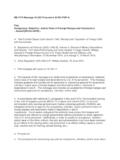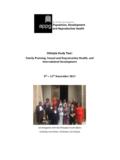Transcription of The Structure of the Ethiopian Economy - A SAM …
1 The Structure of the Ethiopian Economy - A SAM-based Characterisation1 Alemayehu Seyoum Taffesse and Tadele Ferede2 May 2004 I. Introduction Since 1992 the government of ethiopia has introduced a variety of reforms aimed at improving macroeconomic stability, accelerating economic growth, and reducing poverty. Tariffs have been cut, quota constraints relaxed, licensing procedures simplified, foreign exchange controls eased, compulsory grain delivery and forced membership to cooperatives discontinued, a privatisation process begun, private banks authorised, interest rates decontrolled, and an inter-bank money and foreign exchange market introduced. Until recently, one important departure from the past was the abandonment of planning, at least as an explicit mode of government economic policy formulation and implementation.
2 However, beginning 2002 the Ethiopian government has adopted a development strategy centred on the principal goal of poverty reduction. This strategy is officially known as Sustainable Development and Poverty Reduction Program. In line with this Program, the government has recently launched deeper fiscal decentralisation, judicial and civil service reform, and public sector capacity building. Two needs are highlighted by the above paragraphs. First, it is necessary to assess, in a comprehensive manner, the extent to which the reforms implemented so far have changed the Ethiopian Economy . Second, it is necessary to evaluate alternative government policy interventions to facilitate reasonable selections in the context of a medium- to long-term development strategy (and poverty reduction program).
3 Both, in turn, need to be grounded on a good understanding of the current Structure of the Ethiopian Economy . This note contributes towards that understanding by characterising the Ethiopian Economy on the basis of a Social Accounting Matrix (SAM) built for the purpose. Although that is not its primary objective, the note also highlights some of the policy issues implied by this characterisation. The rest of the note is organised into -- sections. Section 2 II. Economic Structure and Social Accounting Matrices (SAMs) The Structure of an Economy can be described in terms of two key sets of The first set is comprised of the types and location of economic activity and the associated technological and 1 This note has been prepared as a background paper for the ethiopia Country Economic Memorandum: World Bank, " ethiopia -A Strategy to Balance and Stimulate Growth", A Country Economic Memorandum, Report No.
4 29383-ET, Green Cover, the World Bank (January 2005). 2 Alemayehu Seyoum Taffesse is the Director of the African Centre for Economic and Historical Studies and Tadele Ferede is a Lecturer in the Department of Economics, Addis Ababa University. 1behavioural relations. It includes the relative importance of sectors in the Economy in terms of production and factor use (such sectoral shares in output and employment), rural vs. urban economic activity, input-output coefficients, openness to trade, saving and investment rates, and expenditure patterns. This set may be referred to as the 'productive' dimension of economic Structure . The types of economic agents/organisations and institutions form the second set. Aspects of property rights systems (such as land tenure system, private ownership and its security, and the extent of public ownership) and behaviourally distinguishable groups (such as households, firms, farmers, wage workers, and entrepreneurs) belong to this set.
5 This set may be considered as the 'distributional' dimension of economic Structure . SAMs are designed as a means of characterising and understanding the Structure of an Economy . By construction, a SAM summarises the transactions (including transfers) among economic agents, and through them activities, in an economic system within an accounting period, commonly a year (Pyatt and Round (1985), Round (2003)). First, the SAM represents a square matrix in which rows and columns denote, respectively, receipts (or incomings) and expenditures (outgoings) of the accounts that correspond to the various institutions, activities, factors and products considered. Transactions are shown in the cells, so the matrix explicitly displays the interconnections in the Economy .
6 As it is an accounting framework not only is the SAM square, but also its corresponding row and column sums must be equal. Second, a SAM is comprehensive, in that it spans all the economic activities of the system (consumption, production, accumulation and distribution) albeit to a varying extent of detail. Indeed, the third attractive feature of the SAM is its flexibility, in terms of both the degree of disaggregation and the emphasis given to different components of the economic system. In short, an appropriately constructed SAM can capture the structural features and interdependencies of an Economy in an efficient and transparent manner. Moreover, such a SAM can be used as a modelling device in its own right or serve as a basis for other modelling strategies such as computable general equilibrium modelling.
7 The 1999/2000 Ethiopian SAM - Key Features The 1999/2000 Ethiopian SAM is a 40x40 matrix and contains an account each for fifteen production activities, four factors of production, eight commodities, transactions costs, eight institutions, public investment, savings/investments of institutions other than the government, food aid, and the rest of the world (net of food aid). As such it captures the diverse production activities and the interdependencies among the various sectors and institutions that characterise the Ethiopian Economy . Activities. The classification of activities reflects a combination of differences in type, location, scale, and ownership Structure of production. Accordingly, activities are disaggregated into five agricultural activities (peasant farming - highland, peasant farming - lowland, peasant livestock production, private commercial farming, and public commercial farming)
8 , seven industrial activities (cottage/handicraft and small scale industry, large/medium scale agro-manufacturing - public, large/medium scale agro-manufacturing - private, large/medium scale other manufacturing - public, large/medium scale other manufacturing - private, other industry - public, and other 3 For a comprehensive characterisation of economic Structure see Syrquin (1988). A related, but broader and somewhat more abstract, characterisation can be found in Tohm and London (1997). 2industry - private), two service activities (services - public and services - private), and a food-for-work activity (see annex for further details).
9 4 A number of unique features are built into the activities block of the SAM. First, peasant agriculture is explicitly disaggregated into highland peasant farming and lowland peasant farming based on growth potential. The essential point of dividing settled peasant farming into highland and lowland is to accommodate differences in agricultural potential between the long-settled (and thus more degraded) highlands and other parts of the country. As such this disaggregation captures, albeit in a rough manner, some of the diversity in physical and biological potential across regions. Second, the desire to assess the currently substantial contribution of livestock production and its as yet to be fully tapped potential motivated the explicit and separate inclusion of a peasant livestock production activity.
10 It is for the first time that this activity is explicitly incorporated in a SAM framework at the national Since the bulk of the output of this sector (especially the part exported) comes from the pastoralist areas, this inclusion also provides a handle on the impact of shocks and interventions on these relatively less understood parts of the country. Third, a food-for-work activity is introduced to capture the potentially significant role that food aid plays via such programs. As an activity it produces public infrastructure (such as roads, terraces and irrigation canals) and incomes to rural households. The demand for public goods produced counts as investment demand. There is also an enterprise account corresponding to this activity titled food-for-work projects.
















